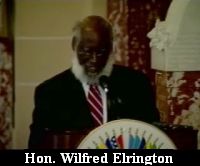
"Do you agree that any legal claim of Guatemala against Belize
relating to land and insular territories and to any maritime areas pertaining
to these territories should be submitted to the International Court of Justice
for final settlement and that it determine finally the boundaries of the respective
territories and areas of the parties?"
That's exactly the question you will have to answer in a referendum on the Belize
Guatemala issue. The historic step forward was made today in
Washington D.C. when Foreign Ministers for both countries, Wilfred Elrington
and Roger Haroldo Rodas Melgar signed the agreement at the Organization of American
States. It was witnessed by the Secretary General of the OAS Jose Miguel
Insulza before a gallery of diplomats. Belize's media also had wide representation
- much more so than Guatemala. Our News Director Jules Vasquez was
right there and he sent us these remarks of Foreign Minister Wilfred
Elrington after the signing.
Hon. Wilfred Sedi Elrington,
"We Belizeans have always maintained that the Guatemalan claim is
unjust, unfounded, and wrong. Guatemala having recognizing Belize's independence
and right of its people to self-determination refuses to acknowledge Belize's
territorial integrity and the inviolability of its borders. We are now at that
cross roads. Having exhausted negotiating efforts we are at that stage when  we must contemplate submitting our case to legal scrutiny by the highest judicial
organ of the United Nations.
we must contemplate submitting our case to legal scrutiny by the highest judicial
organ of the United Nations.
Before that crucial step is taken, the people of Belize and the people
of Guatemala must first decide through referenda whether they approve of this
process. There can be no doubt of commitment to the peaceful settlement of disputes
as enshrined in the Charter of the Organization of American States. Neither
can there be any doubt in our abiding faith in the rule of law and the need
for peace and stability among nations. Our good faith efforts and our respect
and commitment to democracy and good governance will manifest itself when we
submit today's agreement to national referenda.
Allow me at this time to express my government's gratitude once again
to the negotiators, Ambassador Raul Largo of the OAS and Ambassador Pulilo also
of the OAS who regrettably recently passed away for their expertise and effort
that enabled the preparation of the Special Agreement within the time that had
been agreed.
To the group of friends of Belize and Guatemala I say that this could not
be possible without your unwavering support. Your investment in peace in the
Central American region as manifested in your generous contribution in the financing
of the process has yielded dividends and as we express our appreciation for
your support, I must tell you that we will need even more in the steps ahead.
To you Mr. Secretary General I wish to express congratulations and thanks
for the benefit of your insight and sound judgement on which you have successfully
relied in this critical phase. The stature that you bring to the OAS has cemented
the credibility of our organization and the fact that we are here today signing
this agreement and joint declaration is testament to the relevance of the OAS;
that it responds to its members' need and that it is delivering on its
Charter.
Finally to my colleague and esteemed Minister of Foreign Affairs of the
Republic of Guatemala. Let it be said that history will remember you as one
of the architects of what portents to be the lasting solution to our differences."
The signing is seen as a major diplomatic breakthrough, in fact it is
considered by some to be the first treaty between Guatemala and Belize
to resolve the border dispute. And while it is a triumph of diplomacy,
it also marks the end of the diplomatic effort towards a settled resolution;
the matter is now in the hands of the people and to some extent, the politicians
in both countries who must decide whether or not to take it to a referendum.
And a few notes. First, the cormpromis is basically a goodwill undertaking
at this time and only enters into force upon the exchange of what are known
as instruments of ratification - which can only happen after and if the referenda
are passed by voters in both countries. If it gets a "yes" vote in
referenda, the Special Agreement dictates that three months after the court's
judgement both countries will form a bi-national commission to carry out the
marking of boundaries in line with what the court has ordered.
But we're a very far way from there, there are many, many hoops to get through
before that. Jules Vasquez will have a full report with all the inside images
of the events and closed door meetings leading up to the signing. Until then,
the compromis - all 4 pages and 1,200 words of it - has been released by the
government and you can read it at Special
Agreement.
In related news, the British and United States governments today issued
statements supporting the signing of the Special Agreement. UK Minister Gillian
Merron calls the signing of the agreement "an important step that demonstrates
a positive commitment by both governments to reach a mutually agreed solution."
Noting that both countries will create a fund to contribute to the legal costs
she announced that announce that the UK will make an initial contribution of
£200,000 to this fund. The U.S. statement it says that country looks forward
to continued cooperation and participation in the effort.
And that support will be needed. A report on the confidence building
measures reports that due to lack of funds, the OAS Adjacency Office may have
to close after February of 2009. Again, we'll have much more tomorrow so tune
in for that.



